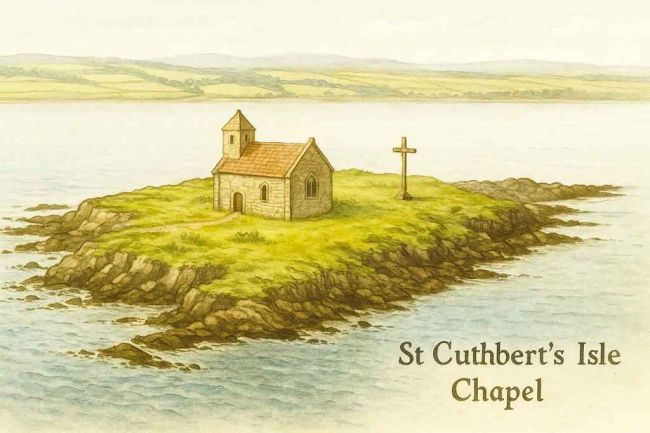Written by David Caldwell ·
Saint Cuthbert: Life, Death & Legacy of Lindisfarne’s Saint
Saint Cuthbert: The Life, Death, and Restless Journey of Northumbria’s Holy Man
Saint Cuthbert remains one of the most beloved saints of the North, his story woven into the very fabric of England’s medieval church, folklore, and even the landscape itself. Born into obscurity in the 7th century, he rose from shepherd boy to bishop, hermit, and miracle-worker, leaving behind a legacy that survived Viking invasions, Reformation dismantlings, and centuries of shifting devotion. His feast day, March 20th, is still marked today, more than twelve hundred years after his death.
This long form article draws from historical accounts, folklore, and early modern journalism to piece together the life, death, relics, and posthumous wanderings of Northumbria’s most famous saint.

A Boy of the Border Hills
Cuthbert’s youth was marked by vigour, games, and visions. Legends tell of him as a lively child, excelling in running, wrestling, and play among the Border hills. Yet there was always a deeper current beneath his spirited nature. One day, while roughhousing with other boys, a child rebuked him: “Why do you waste your time in idle sport? God has set you apart to be a priest and bishop.” The words struck him like prophecy, planting the seeds of a more serious and contemplative life.
He tended sheep near the Lammermuir Hills, where one night in 651 he saw a vision of St. Aidan’s soul ascending to heaven. It was this vision that drew him to monastic life. The boy who once led in games would soon lead in prayer.
Accounts describe Cuthbert as hardy and cheerful, accustomed to outdoor life and the harsh winds of the Scottish borders. He was remembered for his ability to endure hardship and inspire others with his sunny temperament. His playfulness never deserted him, but from a young age, a spiritual seriousness shone through.
The Making of a Monk
Cuthbert entered the monastery at Melrose and quickly became known for his kindness and devotion. His contemporaries noted his simple diet, his readiness for manual labour, and his ability to win over people in their own rustic dialect. He travelled tirelessly across Northumbria, preaching among plague-ridden villages and restoring the faith of communities that had slipped into pagan customs.
Later he was sent to Lindisfarne, the island monastery that became his spiritual home. Here, Cuthbert combined discipline with compassion, smoothing disputes and guiding the brethren. His reputation grew not just as a preacher but as a healer - countless stories tell of him curing the sick, blessing the dying, and even reviving children thought lost.
During his early monastic life, the church in England was divided between Celtic and Roman practices. The Synod of Whitby in 664 sought to unify the church, resolving differences over Easter and clerical tonsure. While Cuthbert had roots in the Celtic tradition, he worked to reconcile divisions, winning people over through patience rather than harshness.
Cuthbert the Preacher
Cuthbert was remarkable not for lofty sermons but for his ability to reach common folk. He was described as “homely in his manners” and able to speak to villagers in their own tongue. While some missionaries required interpreters, Cuthbert needed none. He wandered across the wilds of Northumbria, on foot or horseback, through plague-stricken lands, urging the people to hold fast to Christianity.
One chronicler noted how his rustic accent endeared him to his audiences. Another observed that when plague swept through the villages, many fell back into charms and pagan amulets, but Cuthbert patiently restored their faith.
The Hermit of Farne
Despite the honour of being elected bishop of Lindisfarne, Cuthbert longed for solitude. He withdrew to Inner Farne, a bare and wind-lashed island, where he built a stone cell so deep that he could see only the sky. He sowed barley, tended his own food, and endured winters with nothing but prayer and the company of seabirds. His hermitage became legendary: monks whispered that evil spirits haunted the island, yet Cuthbert believed that Christ’s soldier must fight where the darkness was greatest.
Among the many legends attached to his solitude is the story of the otters. One bitter night, after praying waist-deep in the freezing sea, he was restored by two otters who rubbed warmth into his frozen limbs before disappearing back into the waves. The story became emblematic of Cuthbert’s closeness to the natural world, where even the animals ministered to him.
He endured trials of the spirit as well as the body. Tales survive of him wrestling with demons on the Farne and keeping night-long vigils by the sea. Yet he also found peace in the solitude, and it was here that his fame as a saint truly spread.
Bishop of Lindisfarne
Despite his desire for solitude, Cuthbert was eventually persuaded to become Bishop of Lindisfarne in 685. Reluctant at first, he accepted the office out of obedience. As bishop, he combined his administrative duties with his pastoral heart, continuing to heal the sick, bless the poor, and guide his flock.
Cuthbert’s episcopate was short. Within two years, sensing his end was near, he resigned and returned to his hermitage on Farne. There, he prepared for death in prayer and isolation.
Death and Incorruption
Cuthbert died on March 20, 687, in his hermitage on Farne. He had foretold his death and requested to be buried simply on the island. But the monks of Lindisfarne, revering him as a saint, carried his body back to their church. Eleven years later, when his coffin was opened, they found his body incorrupt - perfect and undecayed. This was seen as divine confirmation of his sanctity.
Among the relics buried with him was an ivory comb, 6¼ inches long, with a double row of teeth and a round hole for the finger. Such combs were once buried with the dead as sacred symbols of purity. Today, the comb remains preserved at Durham - a small, intimate artefact linking us directly to the saint.
The Wandering Saint
Cuthbert’s peace was not to last. In 875, Viking raids forced the monks to carry his coffin across Northumbria. For seven years his body was borne from place to place: through Melrose, Chester-le-Street, Ripon, Norham, and even as far as Southport, where local tradition claims a church now marks a resting spot. Lancashire, too, preserves sites - twelve in total - where his coffin is said to have paused, including Middleton. At each halt, churches were raised to honour him.
The wandering continued until 995, when the monks settled at Durham. There, his shrine became one of the most famous pilgrimage destinations in Europe. Even after the shrine was destroyed at the Reformation, Cuthbert’s relics were carefully reinterred beneath the site of his great cathedral.
Durham and the Shrine
Durham Cathedral became the resting place of Cuthbert’s relics and the centre of his cult. Pilgrims travelled from across Christendom to seek blessings at his shrine. The coffin was opened several times over the centuries, and each time his body was reported incorrupt. Richly adorned shrines and reliquaries surrounded his relics, and treasures such as the Lindisfarne Gospels were associated with his memory.
Even when Henry VIII ordered the shrine dismantled, the commissioners were reportedly awed by the incorrupt state of his remains. Though stripped of its splendour, the body was reburied in the cathedral, where it rests today.
Folklore and Legacy
Cuthbert’s legacy is woven not only into churches and relics but also into folklore. His name lives on in “Cuddy’s Well” at Bellingham, where waters were said to work miracles, and in the “Cuddy Duck,” the eider birds of the Farne Islands, still associated with him. Legends abound of his donkey, his staff, and his healing powers.
The churches dedicated to him across England - from Lindisfarne to Southport - mark the path of his posthumous wanderings. Each stone and dedication bears witness to a community touched by his story.
Saint Cuthbert
Saint Cuthbert’s story is one of resilience - of faith carried through storm and exile, of relics preserved through centuries of upheaval, of a man whose body would not rest until a permanent sanctuary was found. His life bridged the worlds of shepherd and bishop, hermit and healer. His relics, from the simple ivory comb to the great Lindisfarne Gospels, continue to speak of a time when holiness and scholarship walked hand in hand.
For over twelve centuries, his name has been a household word in the North. Cuthbert remains not only Northumbria’s favourite saint but a symbol of endurance, simplicity, and sanctity.
Related Articles
4 October 2025
The Ancient Blood: A History of the Vampire27 September 2025
Epona: The Horse Goddess in Britain and Beyond26 September 2025
Witchcraft is Priestcraft: Jane Wenham and the End of England’s Witches20 September 2025
The Origins of Easter: From Ishtar and Passover to Eggs and the Bunny7 September 2025
The Search for the Ark of the Covenant: From Egypt to Ethiopia5 September 2025
The Search for Camelot: Legend, Theories, and Evidence1 September 2025
The Hell Hound Legends of Britain25 August 2025
The Lore of the Unicorn - A Definitive Guide23 August 2025
Saint Edmund: King, Martyr, and the Making of a Cult14 August 2025
The Great Serpent of Sea and Lake11 August 2025
The Dog Days of Summer - meanings and origins24 June 2025
The Evolution of Guardian Angels19 June 2025
Dumnonia The Sea Kingdom of the West17 June 2025
The Roman Calendar, Timekeeping in Ancient Rome14 June 2025
Are There Only Male Angels?